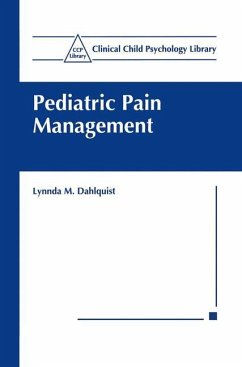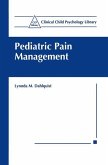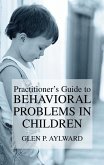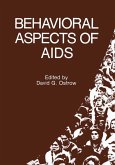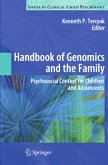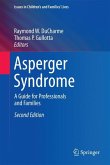Lynnda M. Dahlquist
Pediatric Pain Management
Lynnda M. Dahlquist
Pediatric Pain Management
- Gebundenes Buch
- Merkliste
- Auf die Merkliste
- Bewerten Bewerten
- Teilen
- Produkt teilen
- Produkterinnerung
- Produkterinnerung
Pain is a complex, multidimensional phenomenon, with physiological, behav ioral, emotional, cognitive, and developmental aspects (Zeltzer, Barr, McGrath, & Schechter, 1992). To effectively evaluate and manage pain in children, the clini cian must be able to assess the unique ways these complex dimensions interact for the individual child and integrate these dimensions into a treatment plan. This can be a daunting task. The purpose of this book is to provide a framework for conceptualizing pain problems in children that can guide the practitioner in developing an evaluation and treatment plan…mehr
Andere Kunden interessierten sich auch für
![Pediatric Pain Management Pediatric Pain Management]() Lynnda M. DahlquistPediatric Pain Management77,99 €
Lynnda M. DahlquistPediatric Pain Management77,99 €![Practitioner¿s Guide to Behavioral Problems in Children Practitioner¿s Guide to Behavioral Problems in Children]() Glen P. AylwardPractitioner¿s Guide to Behavioral Problems in Children77,99 €
Glen P. AylwardPractitioner¿s Guide to Behavioral Problems in Children77,99 €![Behavioral Aspects of AIDS Behavioral Aspects of AIDS]() David G. Ostrow (Hrsg.)Behavioral Aspects of AIDS77,99 €
David G. Ostrow (Hrsg.)Behavioral Aspects of AIDS77,99 €![Handbook of Genomics and the Family Handbook of Genomics and the Family]() Handbook of Genomics and the Family200,99 €
Handbook of Genomics and the Family200,99 €![Handbook of Genomics and the Family Handbook of Genomics and the Family]() Kenneth P. Tercyak (Hrsg.)Handbook of Genomics and the Family284,99 €
Kenneth P. Tercyak (Hrsg.)Handbook of Genomics and the Family284,99 €![Understanding Asperger Syndrome and High Functioning Autism Understanding Asperger Syndrome and High Functioning Autism]() Gary B. MesibovUnderstanding Asperger Syndrome and High Functioning Autism75,99 €
Gary B. MesibovUnderstanding Asperger Syndrome and High Functioning Autism75,99 €![Asperger Syndrome Asperger Syndrome]() Asperger Syndrome112,99 €
Asperger Syndrome112,99 €-
-
-
Pain is a complex, multidimensional phenomenon, with physiological, behav ioral, emotional, cognitive, and developmental aspects (Zeltzer, Barr, McGrath, & Schechter, 1992). To effectively evaluate and manage pain in children, the clini cian must be able to assess the unique ways these complex dimensions interact for the individual child and integrate these dimensions into a treatment plan. This can be a daunting task. The purpose of this book is to provide a framework for conceptualizing pain problems in children that can guide the practitioner in developing an evaluation and treatment plan that is optimal for the individual child. This book is not in tended to be a comprehensive, exhaustive review of the literature on pain manage ment in children. There are several excellent books of this nature (e.g., Bush & Harkins, 1991: McGrath, 1990; Ross & Ross, 1988). Instead, this book is an at tempt to outline an hypothesis testing process of case conceptualizing and treat ment planning that can help structure the task of sorting through the complex interrelationships that determine children's pain.
Hinweis: Dieser Artikel kann nur an eine deutsche Lieferadresse ausgeliefert werden.
Hinweis: Dieser Artikel kann nur an eine deutsche Lieferadresse ausgeliefert werden.
Produktdetails
- Produktdetails
- Clinical Child Psychology Library
- Verlag: Springer / Springer US / Springer, Berlin
- Artikelnr. des Verlages: 978-0-306-46084-5
- 1999.
- Seitenzahl: 204
- Erscheinungstermin: 31. Mai 1999
- Englisch
- Abmessung: 241mm x 160mm x 16mm
- Gewicht: 458g
- ISBN-13: 9780306460845
- ISBN-10: 030646084X
- Artikelnr.: 23077762
- Herstellerkennzeichnung
- Springer-Verlag GmbH
- Tiergartenstr. 17
- 69121 Heidelberg
- ProductSafety@springernature.com
- Clinical Child Psychology Library
- Verlag: Springer / Springer US / Springer, Berlin
- Artikelnr. des Verlages: 978-0-306-46084-5
- 1999.
- Seitenzahl: 204
- Erscheinungstermin: 31. Mai 1999
- Englisch
- Abmessung: 241mm x 160mm x 16mm
- Gewicht: 458g
- ISBN-13: 9780306460845
- ISBN-10: 030646084X
- Artikelnr.: 23077762
- Herstellerkennzeichnung
- Springer-Verlag GmbH
- Tiergartenstr. 17
- 69121 Heidelberg
- ProductSafety@springernature.com
What Is Pain?.- Evaluating Pain in Children.- The Hypothesis Testing Model.- Developing an Operational Definition of the Child's Pain Problem.- The Child's Perspective.- The Family Context.- The Medical Context in Which the Pain Problem Occurs.- The Social Context.- Generating Hypotheses Regarding Physical Contributors to the Child's Pain.- Generating Hypotheses Regarding the Child's Physical Pain.- Generating Hypotheses Regarding Cognitive and Emotional Contributors to the Child's Pain.- Is the Child's Attention Focused on the Pain?.- Is Anxiety or Stress Exacerbating the Child's Pain?.- Does the Child Engage in Self-Defeating Thinking about the Pain?.- Does the Pain Have Significant Emotional Meaning for the Child?.- Is the Caregiver's Emotional or Cognitive Status Interfering with His/Her Ability to Help the Child Manage the Pain?.- Generating Hypotheses Regarding Behavioral Contributors to the Child's Pain.- Pain Behavior in Children.- To What Degree Is the Child's Pain Behavior Positively Reinforced?.- To What Degree Is the Child's Pain Behavior Negatively Reinforced?.- Is Adaptive Behavior Inadequately Reinforced or Actually Punished?.- Does the Child Lack the Skills Necessary to Perform the Adaptive Behavior(s)?.- Adult Responses to the Child's Pain.- Developing an Evaluation Plan.- Measuring the Child's Pain.- Location of Pain.- Intensity of Pain.- Frequency of Pain.- Duration of Pain.- Quality of Pain.- Pain-Free Periods.- Goals of Assessment.- Testing Hypotheses Regarding Physical Contributors to the Child's Pain.- Is the Child Receiving Less than Optimal Pain Medication?.- Are Medications that Are Likely to Help the Child's Pain Not Being Used?.- Are Pain Medications Being Administered Inappropriately or in a Less than IdealManner?.- Are Other Physical Factors Exacerbating the Child's Pain?.- Testing Hypotheses Regarding Cognitive and Emotional Contributors to the Child's Pain.- Is the Child's Attention Focused on the Pain?.- Is Anxiety or Stress Exacerbating the Child's Pain?.- Does the Child Engage in Self-Defeating Thinking about the Pain?.- Does the Pain Have Significant Emotional Meaning for the Child?.- Is the Caregiver's Emotional or Cognitive Status Interfering with His/Her Ability to Assist the Child in Managing the Pain?.- Testing Hypotheses Regarding Behavioral Contributors to the Child's Pain.- The Child's Pain Behaviors and Pain Coping Behaviors.- Adult Responses to the Child.- Case Example.- Treating Physical Contributors to the Child's Pain.- Problem: The Child Is Receiving Less than Optimal Pain Medication.- Recommend Consideration of a Stronger or Different Medication.- Problem: Other Physical Factors Are Exacerbating the Child's Pain.- Treating Cognitive and Emotional Contributors to the Child's Pain.- Problem: The Child's Attention Is Focused on the Pain.- Problem: Anxiety Is Exacerbating the Child's Pain.- Problem: The Child Engages in Self-Defeating Thinking about the Pain.- Problem: The Pain Has Specific Meaning for the Child.- Problem: The Caregiver's Emotional Status Is Interfering with His/Her Ability to Help the Child Manage the Pain.- Treating Behavioral Contributors to the Child's Pain.- Provide a Rationale for Changing Existing Contingencies that the Child and Family Can Understand and Accept.- Define the Target Behaviors.- Problem: The Child's Pain Behaviors Are Positively Reinforced.- Problem: The Child's Pain Behavior Is Negatively Reinforced.- Problem: The Child's Adaptive Behavior Is Punished or Inadequately Reinforced.-Problem: The Child Lacks Skills Necessary to Perform Adaptive Behaviors.- Case Example.- Working with the Parent and the Health Care System.- Problem: The Adult's Problematic Behavior Is Positively Reinforced.- Problem: The Adult's Problematic Behavior Is Negatively Reinforced.- Problem: Appropriate Adult Behavior Is Inadequately Reinforced or Punished.- Problem: The Adult Lacks the Skills Needed to Deal More Effectively with the Child.- Implementing the Pain Management Program.- Establish a Therapeutic Contract.- Establish the Immediate and Long-Range Goals of Treatment.- Determine the Means by Which Treatment Efficacy Will Be Measured.- Plan and Implement the Pain Management Intervention.- Conduct an Ongoing Evaluation of Treatment Effectiveness.- Revise the Treatment Plan if Necessary.- Case Example.- Concluding Comments.- References.- Appendix A. Generating Hypotheses/Evaluation Planning Worksheet.- Appendix B. Treatment Planning Worksheet.- Appendix C. Peer Interaction Record (PIR).- Appendix D. Selected Readings.
What Is Pain?.- Evaluating Pain in Children.- The Hypothesis Testing Model.- Developing an Operational Definition of the Child's Pain Problem.- The Child's Perspective.- The Family Context.- The Medical Context in Which the Pain Problem Occurs.- The Social Context.- Generating Hypotheses Regarding Physical Contributors to the Child's Pain.- Generating Hypotheses Regarding the Child's Physical Pain.- Generating Hypotheses Regarding Cognitive and Emotional Contributors to the Child's Pain.- Is the Child's Attention Focused on the Pain?.- Is Anxiety or Stress Exacerbating the Child's Pain?.- Does the Child Engage in Self-Defeating Thinking about the Pain?.- Does the Pain Have Significant Emotional Meaning for the Child?.- Is the Caregiver's Emotional or Cognitive Status Interfering with His/Her Ability to Help the Child Manage the Pain?.- Generating Hypotheses Regarding Behavioral Contributors to the Child's Pain.- Pain Behavior in Children.- To What Degree Is the Child's Pain Behavior Positively Reinforced?.- To What Degree Is the Child's Pain Behavior Negatively Reinforced?.- Is Adaptive Behavior Inadequately Reinforced or Actually Punished?.- Does the Child Lack the Skills Necessary to Perform the Adaptive Behavior(s)?.- Adult Responses to the Child's Pain.- Developing an Evaluation Plan.- Measuring the Child's Pain.- Location of Pain.- Intensity of Pain.- Frequency of Pain.- Duration of Pain.- Quality of Pain.- Pain-Free Periods.- Goals of Assessment.- Testing Hypotheses Regarding Physical Contributors to the Child's Pain.- Is the Child Receiving Less than Optimal Pain Medication?.- Are Medications that Are Likely to Help the Child's Pain Not Being Used?.- Are Pain Medications Being Administered Inappropriately or in a Less than IdealManner?.- Are Other Physical Factors Exacerbating the Child's Pain?.- Testing Hypotheses Regarding Cognitive and Emotional Contributors to the Child's Pain.- Is the Child's Attention Focused on the Pain?.- Is Anxiety or Stress Exacerbating the Child's Pain?.- Does the Child Engage in Self-Defeating Thinking about the Pain?.- Does the Pain Have Significant Emotional Meaning for the Child?.- Is the Caregiver's Emotional or Cognitive Status Interfering with His/Her Ability to Assist the Child in Managing the Pain?.- Testing Hypotheses Regarding Behavioral Contributors to the Child's Pain.- The Child's Pain Behaviors and Pain Coping Behaviors.- Adult Responses to the Child.- Case Example.- Treating Physical Contributors to the Child's Pain.- Problem: The Child Is Receiving Less than Optimal Pain Medication.- Recommend Consideration of a Stronger or Different Medication.- Problem: Other Physical Factors Are Exacerbating the Child's Pain.- Treating Cognitive and Emotional Contributors to the Child's Pain.- Problem: The Child's Attention Is Focused on the Pain.- Problem: Anxiety Is Exacerbating the Child's Pain.- Problem: The Child Engages in Self-Defeating Thinking about the Pain.- Problem: The Pain Has Specific Meaning for the Child.- Problem: The Caregiver's Emotional Status Is Interfering with His/Her Ability to Help the Child Manage the Pain.- Treating Behavioral Contributors to the Child's Pain.- Provide a Rationale for Changing Existing Contingencies that the Child and Family Can Understand and Accept.- Define the Target Behaviors.- Problem: The Child's Pain Behaviors Are Positively Reinforced.- Problem: The Child's Pain Behavior Is Negatively Reinforced.- Problem: The Child's Adaptive Behavior Is Punished or Inadequately Reinforced.-Problem: The Child Lacks Skills Necessary to Perform Adaptive Behaviors.- Case Example.- Working with the Parent and the Health Care System.- Problem: The Adult's Problematic Behavior Is Positively Reinforced.- Problem: The Adult's Problematic Behavior Is Negatively Reinforced.- Problem: Appropriate Adult Behavior Is Inadequately Reinforced or Punished.- Problem: The Adult Lacks the Skills Needed to Deal More Effectively with the Child.- Implementing the Pain Management Program.- Establish a Therapeutic Contract.- Establish the Immediate and Long-Range Goals of Treatment.- Determine the Means by Which Treatment Efficacy Will Be Measured.- Plan and Implement the Pain Management Intervention.- Conduct an Ongoing Evaluation of Treatment Effectiveness.- Revise the Treatment Plan if Necessary.- Case Example.- Concluding Comments.- References.- Appendix A. Generating Hypotheses/Evaluation Planning Worksheet.- Appendix B. Treatment Planning Worksheet.- Appendix C. Peer Interaction Record (PIR).- Appendix D. Selected Readings.

